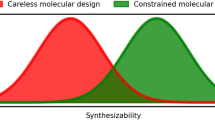Abstract
De novo design provides an in silico toolkit for the design of novel small molecular structures to a set of specified structural constraints. With the avalanche of bioinformatics data, de novo design is ideally suited for exploring molecules that could be useful for chemical genomics. The design process involves manipulation of the input, modification of structural constraints, and further processing of the de novo generated molecules using various modular toolkits. The development of a theoretical framework for each of these stages will provide novel practical solutions to the problem of creating compounds with maximal chemical diversity. This short review describes the fundamental problems encountered in the application of novel chemical design technologies to chemical genomics by means of a formal representation. This notation helps to outline and clarify ideas and hypotheses that can then be explored using mathematical algorithms. It is only by developing this rigorous foundation that in silico design can progress in a rational way.


Similar content being viewed by others
References
Read, J., Pearce, J., Li, X., Muirhead, H., Chirgwin, J., & Davies, C. (2001). The crystal structure of human phosphoglucose isomerase at 1.6A resolution: Implications for catalytic mechanism, cytokine activity and haemolytic anaemia. Journal of Molecular Biology, 309, 447–463.
Tsutsumi, S., Yanagawa, T., Shimura, T., Fukumori, T., Hogan, V., Kuwano, H., & Raz, A. (2003). Regulation of cell proliferation by autocrine motility factor/phospoglucose isomerase signaling. Journal of Biological Chemistry, 278, 32165–32172.
Ohi, M. D., Vander Kooi, C. W., Rosenberg, J. A., Chazin, W. J., & Gould, K. L. (2003). Structural insights into the U-box, a domain associated with multi-ubiquitination. Nature Structural Biology, 10, 250–255.
Bohacek, R. S., Martin, C., & Guida, W. C. (1996). The art and practice of structure-based drug design: A molecular modeling perspective. Medical Research Review, 16, 3–50.
Magwene, P. M., & Kim, J. (2004). Estimating genomic coexpression networks using first-order conditional independence. Genome Biology 5, R100.1–R100.16.
di Bernardo, D., Thompson, M. J., Gardener, T. S., Chobot, S. E., Eastwood, E. L., Wojtovich, A. P., Elliot, S. J., Schaus, S. E., & Collins, J. J. (2005). Chemogenomic profiling on a genome-wide scale using reverse-engineered gene networks. Nature Biotechnology, 23, 377–383.
Zhou, X., Wang, X., & Dougherty, E. R. (2003). Construction of genomic networks using mutual-information clustering and reversible-jump Markov chain Monte-Carlo predictor design. Signal Processing, 83, 745–761.
Hartemink, A. J., Gifford, D. K., Jaakola, T. S., & Young, R. A. (2001). Using graphical models and genomic expression data to statistically validate models of genetic regulatory networks. Pacific Symposium in Biocomputing, 6, 422–433.
Shah, N. P., et al. (2002). Multiple BRC-ABL kinase domain mutations confer polyclonal resistance to the tyrosine kinase inhibitor imatinib (ST1571) in chronic phase and blast crisis chronic myeloid leukemia. Cancer Cell, 2, 117–125.
Shah, N. P., et al. (2004). Overriding imatinib resistance with a novel ABL kinase inhibitor. Science, 305, 399–400.
Azam, M., Nardi, V., Shakespeare, W. C., Metcalf, C. A., Bohacek, R. S., Wang, Y., Sundaramoorthi, R., Sliz, P., Veach, D. R., Bornmann, W. G., Clarkson, B., Dalgarno, D. C., Sawyer, T. K., & Daley, G. Q. (2006). Activity of dual SRC/ABL inhibitors highlights the role of BCR/ABL kinase dynamics in drug resistance. PNAS, 103, 9244–9249.
Duarte, N. C., Becker, S. A., Jamshidi, N., Thiele, I., Mo, M. L., Vo, T. D., Srivas, R., & Palsson, B. O. (2007). Global reconstruction of the human metabolic network based on genomic and bibliomic data. PNAS, 104, 1777–1782.
Koonin, E. V. (1999). http://kr.expasy.org/cgi-bin/prosite-search-ac?PDOC00017
Deng, Z., Chuaqui, C., & Singh, J. (2004). Structural interaction fingerprint (SIFt): A novel method for analyzing three-dimensional protein-ligand binding interactions. Journal of Medical Chemistry 47, 337–344.
Levitt, M. (2007). Growth of novel protein structural data. PNAS, 104, 3183–3188.
O’Toole, N., Raymond, S., & Cygler, M. (2003). Coverage of protein sequence space by current structural genomics. Journal of Structural and Functional Genomics, 4, 47–55.
Todorov, N. P., Alberts, I. L., Dean, P. M. (2007). De novo design. In J. Mason (Ed.), Comprehensive medicinal chemistry II, Vol. 4, Chapter 13, (pp. 283–305). Elzevier Ltd.
Todorov, N. P., & Dean, P. M. (1997). An evaluation of a method for controlling molecular scaffold diversity in de novo ligand design. Journal of Computer-Aided Molecular Design, 11, 175–192.
Mancera, R. L. (2002). De novo ligand design with explicit water molecules: an application to bacterial neuraminidase. Journal of Computer-Aided Molecular Design, 16, 479–499.
Lloyd, G. G., Garcia-Sosa, A., Alberts, I. L., Todorov, N. P., & Mancera, R. L. (2004a). The effect of tightly bound water molecules on the structural interpretation of ligand-derived pharmacophore models. Journal of Computer-Aided Molecular Design, 18, 89–100.
Stahl, M., Todorov, N. P., Tames, T., Mauser, H., Boehm, H.-J., & Dean, P. M. (2002). A validation study on the practical use of de novo design. Journal of Computer-Aided Molecular Design, 16, 459–478.
Firth-Clark, S., Todorov, N. P., Alberts, I. L., Williams, A., James, T., & Dean, P. M. (2006). Exhaustive de novo design of low-molecular weight fragments against the ATP-binding site of DNA-gyrase. Journal of Chemical Information Modelling, 46, 1168–1173.
Lloyd, D. G., Buenemann, C. L., Todorov, N. P., Manallack, D. T., & Dean, P. M. (2004b). Scaffold hopping in de novo drug design – ligand generation in the absence of receptor information. Journal of Medical Chemistry, 47, 493–496.
Author information
Authors and Affiliations
Corresponding author
Rights and permissions
About this article
Cite this article
Dean, P.M. Chemical genomics: a challenge for de novo drug design. Mol Biotechnol 37, 237–245 (2007). https://doi.org/10.1007/s12033-007-0037-x
Received:
Accepted:
Published:
Issue Date:
DOI: https://doi.org/10.1007/s12033-007-0037-x




